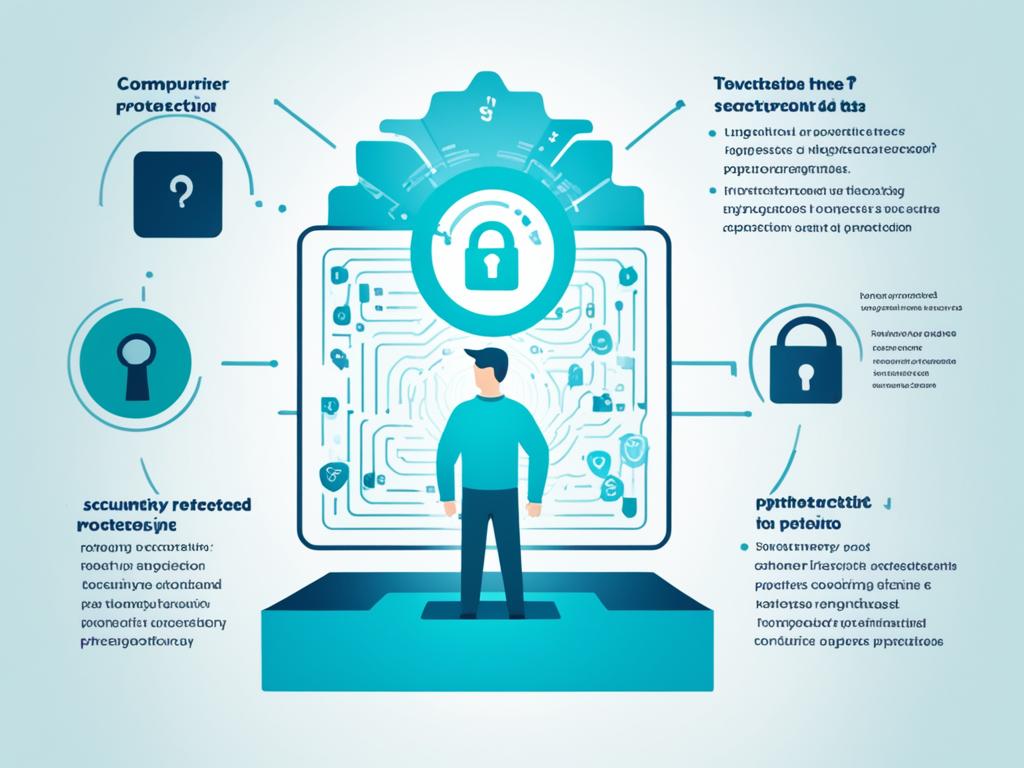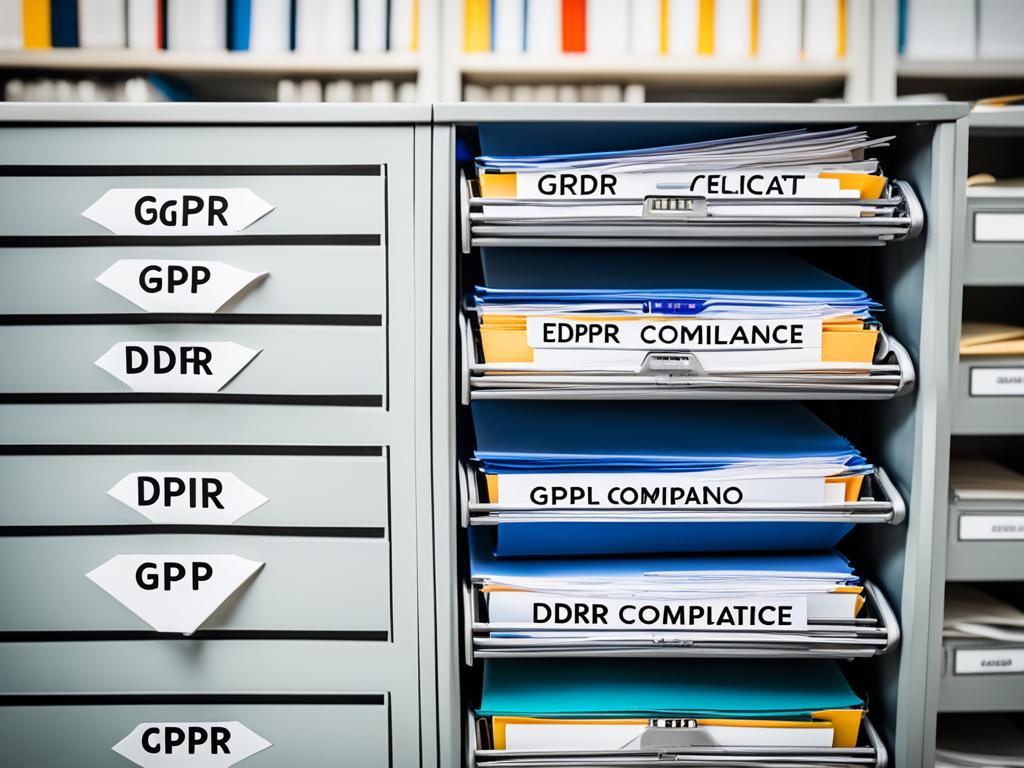Imagine your company facing a huge €20 million fine or 4% of your yearly sales for not following the EU’s GDPR. This is a real worry, with over €114 million in fines in just 20 months. GDPR is a big deal for companies all over the world, no matter where they are or what they do.
This guide will give you the key info you need to get your company GDPR-ready. You’ll learn about the law’s rules and how to keep your customers’ data safe. This way, you can avoid big fines and keep your customers’ trust.
Key Takeaways
- GDPR is a strong data privacy law from the European Union to protect people’s personal data.
- It covers any company that handles EU residents’ data, even if it’s not in the EU.
- To follow GDPR, you must get consent, respect people’s rights, and use strong security.
- If you don’t follow GDPR, you could face fines up to €20 million or 4% of your yearly sales.
- Use a GDPR checklist to make sure you’re meeting all the rules.
Understanding GDPR and Its Scope
The General Data Protection Regulation (GDPR) is a key privacy law from the European Union. It gives more control to people over their personal data. It affects businesses worldwide that handle EU residents’ personal info. If you run a business, knowing GDPR is key to follow the law and avoid big fines.
What is GDPR?
GDPR is a detailed law that makes data protection rules the same across Europe. It started on May 25, 2018, and updated old rules from 1995. Its main goals are to give people more control over their data and make rules stricter for companies.
Who Does GDPR Apply To?
GDPR covers any company, no matter where it’s located, that deals with EU or EEA residents’ personal data. This includes companies outside the EU/EEA that sell goods or services to EU/EEA people or watch their online actions. Breaking the rules can lead to huge fines, up to €20 million or 4% of a company’s yearly sales, whichever is more.
It’s important for all businesses to understand GDPR. It protects customer info and avoids the high costs of data breaches. Following GDPR shows a company cares about privacy. This builds trust with customers and strengthens HIPAA Compliance, SOC 2 Compliance, and Identity and Access Management efforts.
GDPR Data Protection Principles
The General Data Protection Regulation (GDPR) has seven core principles for data protection. These principles are key for lawful data processing. It’s vital for digital companies to follow these to stay GDPR compliant.
Lawfulness, Fairness, and Transparency
GDPR Article 5(1)(a) says data must be processed lawfully, fairly, and openly. You need a good reason to collect and use data. And, you must tell people how you’re using their data.
Purpose Limitation and Data Minimization
GDPR Article 5(1)(b) says collect data for clear, valid reasons and not for other uses. Article 5(1)(c) says keep data only as needed for its purpose. This means less data is better.
Accuracy, Storage Limitation, and Integrity
GDPR Article 5(1)(d) makes sure data is correct and updated. Article 5(1)(e) says data should be kept only as long as needed. Article 5(1)(f) stresses the need for secure data with Data Encryption and Cloud Security Compliance.
Not following these GDPR rules can result in big fines, up to £17.5 million or 4% of your yearly sales. It’s crucial to stick to these rules to protect personal data and follow GDPR.
GDPR Data Privacy Requirements
The General Data Protection Regulation (GDPR) has strict rules for protecting personal data. It focuses on making data processing clear and giving data subjects their rights.
Transparency and Communication
GDPR says organizations must be clear about how they use personal data. They need to tell data subjects how their data is handled. Identity and Access Management and Data Encryption help keep data safe and clear.
Rights of Data Subjects
GDPR gives data subjects certain rights. They can ask for their data, correct it, erase it, or limit its use. They can also move their data to another service. Organizations must quickly and well handle these requests.
| Data Subject Right | Description |
|---|---|
| Right to Access | Individuals can ask for their personal data and how it’s processed. |
| Right to Rectification | Individuals can ask to fix wrong or missing personal data. |
| Right to Erasure | Individuals can ask to delete their personal data under certain conditions. |
| Right to Restrict Processing | Individuals can ask to limit how their personal data is used. |
| Right to Data Portability | Individuals can ask for their personal data in a format they can use. |
Following these rules is key for EU organizations or those serving EU citizens. Not following them can lead to big fines.

GDPR Compliance Checklist
Achieving GDPR compliance can seem hard, but it’s easier with clear steps. To meet the GDPR’s strict data privacy rules, follow this checklist:
Conduct a Data Audit
Start by doing a detailed data audit. Find out what personal data your company has, where it’s kept, and how it’s used. See who can see it too. This helps spot any weak spots that need fixing.
Identify Legal Bases for Processing
You need a good reason to process personal data under the GDPR. Reasons include getting consent, meeting a contract, or following the law. Make sure your data handling matches the right legal reasons to show you’re following the rules.
Implement Data Security Measures
Keeping personal data safe is key under the GDPR. Use strong security like encryption and check for cyber threats often. Have plans ready for when data breaches happen. HIPAA Compliance, SOC 2 Compliance, and Cloud Security Compliance are important here.
Follow this checklist to show you care about data privacy. This helps avoid big fines or damage to your reputation. Remember, keeping up with GDPR is ongoing. Regular checks and updates are needed to keep your data safe and secure.
GDPR Compliance and User Consent
Under the General Data Protection Regulation (GDPR), getting valid user consent is key. It’s one of the six legal ways to process personal data. Users must give their consent freely, clearly, and know what they’re agreeing to. Companies need a clear way to ask for consent, often using a double opt-in, to make sure users really agree.
The GDPR says consent means saying yes clearly and freely. It’s when someone shows they agree by saying so or doing something clear. Just being quiet, or having boxes already checked, isn’t enough.
Not following the GDPR’s consent rules can lead to big fines, like the €50 million Google got. The GDPR also says it should be easy to say no later on, without facing problems.
Companies must show they got valid consent, as the GDPR demands. They need to keep track of when and how consent was given. And, the consent process must be free from any bad pressure or influence.
Consent is one way to legally process personal data under the GDPR. But, there are other ways too, like for contracts or legal reasons. If an organization uses consent, they must respect the user’s choice and stop processing if asked.
Maintaining GDPR Compliance Documentation
Following the GDPR’s rules is key for companies. They must keep detailed records of how they handle personal data. This includes their decisions and steps to keep data safe. These records prove a company’s effort to follow GDPR and help in audits.
Being GDPR compliant is an ongoing task. Companies need to keep up with detailed records. They should keep track of their data handling, how it affects people, and their efforts to follow the rules. This is important if there’s a GDPR issue, as it shows a company’s good faith in protecting data.
Keeping good records also puts companies ahead. By checking and updating their records often, they can find ways to get better. They can keep up with new rules and make sure they’re doing the right thing with data. This helps avoid legal problems and builds a culture of openness and responsibility.
The GDPR really stresses the need for good records. It’s a key part of being HIPAA Compliance and SOC 2 Compliance. By focusing on this, companies show they care about privacy. They protect their good name and avoid big problems from not following the rules.

GDPR Compliance and Website Cookies
Today, website cookies are key for tracking user actions and improving the site experience. But, the GDPR makes using cookies complex and regulated. It’s vital for businesses to follow GDPR rules on cookies to avoid big fines and keep users’ trust.
The GDPR says websites must get clear consent from users before setting cookies, except for essential ones. This consent must be given freely, be specific, and easy to change. Sites also need to tell users about the cookies they use, why, and what data they collect.
- GDPR requires websites to get clear consent before setting cookies on devices for personal data processing.
- Consent must be freely given, specific, and easy to change or withdraw.
- Sites must give clear, detailed info on cookie use and data processing.
To follow GDPR, many sites use cookie consent banners or pop-ups. These let users control their cookie choices. Tools like Cookiebot CMP help sites meet rules by offering detailed control over cookies and data.
| Cookie Type | Description | Consent Required |
|---|---|---|
| Strictly Necessary Cookies | Cookies needed for the site’s basic functions, like shopping carts or login. | No |
| Analytical Cookies | Cookies for tracking website use and performance, like Google Analytics. | Yes |
| Marketing Cookies | Cookies for targeted ads and personalization, like Facebook Pixel. | Yes |
The rules on cookies are likely to change as the internet grows. The ePrivacy Regulation, coming soon, will work with GDPR to cover more about cookies and privacy concerns.
Facilitating Data Subject Rights
Making it easy for people to get their personal data or change it is key. This includes the right to access, fix, erase, or move their data. To help, companies should use a Data Subject Rights Request Portal. This is a secure online place where people can ask for their data and get quick answers.
This special portal makes it easy to handle data subject rights. It shows the company cares about GDPR rules. People can ask to see, fix, erase, or move their data easily. The company must answer these requests within a month, sometimes taking two more months for hard cases.
Sometimes, companies can ask for a fee or say no to requests that are not valid. They can ask for more info to check who is asking for the data. If a request can’t be done, the company must tell the person within a month, explaining why and how to complain.
| GDPR Data Subject Rights | CCPA/CPRA Data Subject Rights |
|---|---|
| Access, Rectification, Erasure, Data Portability | Know, Access, Delete, Correct, Opt-Out |
Using strong [Data Encryption] and secure ways to check who you are helps make sure data rights are used safely and openly. Companies should tell people about how they use data, who gets it, how long it’s kept, and what rights they have. This way, companies show they follow GDPR rules and gain trust with their customers.
Conclusion
GDPR compliance is key for companies that handle EU residents’ personal data, no matter where they are. It’s important to know the GDPR rules, follow the data privacy laws, and keep good records. This way, companies can avoid big fines and gain trust with their customers.
It’s vital to keep up with GDPR changes and check your compliance often. This includes making sure you meet HIPAA and SOC 2 standards, and having strong Identity and Access Management. With a focus on Data Encryption and Cloud Security Compliance, GDPR compliance is more important than ever.
GDPR compliance is more than just avoiding fines. It’s about respecting people’s privacy and building trust with your customers. By following GDPR rules and putting data privacy first, you set your company up for success in the digital world.
Source Links
- https://gdpr.eu/ – General Data Protection Regulation (GDPR) Compliance Guidelines
- https://www.onetrust.com/blog/gdpr-compliance/ – Guide to the General Data Protection Regulation (GDPR)
- https://www.endpointprotector.com/epp/gdpr-the-most-in-depth-guide-to-stay-compliant – GDPR Compliance: The Most In-Depth Guide
- https://gdpr.eu/what-is-gdpr/ – What is GDPR, the EU’s new data protection law? – GDPR.eu
- https://termly.io/resources/articles/gdpr-for-dummies/ – GDPR for Dummies
- https://cloudian.com/guides/data-protection/data-protection-principles-7-core-principles-of-the-gdpr/ – Data Protection Principles: Core Principles of the GDPR
- https://ico.org.uk/for-organisations/uk-gdpr-guidance-and-resources/data-protection-principles/a-guide-to-the-data-protection-principles/ – A guide to the data protection principles
- https://gdpr.eu/compliance/ – Everything you need to know about GDPR compliance – GDPR.eu
- https://www.osano.com/articles/gdpr-compliance-regulations – 12 Facts about GDPR Compliance | Articles
- https://gdpr-info.eu/ – General Data Protection Regulation (GDPR) – Legal Text
- https://www.upguard.com/blog/how-to-be-gdpr-compliant – 10-Step Checklist: GDPR Compliance Guide | UpGuard
- https://sprinto.com/blog/gdpr-compliance-checklist/ – GDPR Compliance Checklist (12 Important Steps) – Sprinto
- https://gdpr.eu/gdpr-consent-requirements/ – What are the GDPR consent requirements? – GDPR.eu
- https://gdpr-info.eu/issues/consent/ – Consent – General Data Protection Regulation (GDPR)
- https://pro.bloomberglaw.com/insights/privacy/how-to-comply-with-the-eus-gdpr-in-10-steps/ – How to Comply With the EU’s GDPR in 10 Steps | Bloomberg Law
- https://usercentrics.com/knowledge-hub/gdpr-implementation/ – GDPR Implementation in 12 Steps to Streamline Compliance
- https://crigroup.com/10-ways-to-maintain-gdpr-compliance/ – GDPR Compliance: 10 ways to maintain GDPR compliance
- https://www.cookiebot.com/en/gdpr-cookies/ – GDPR Cookie Consent – GDPR Compliance – Cookiebot™
- https://secureprivacy.ai/blog/understanding-cookies-importance-of-cookie-compliance – Understanding Cookies | Their Role in Your Online Experience and the Importance of Cookie Compliance
- https://www.iubenda.com/en/help/5525-cookies-gdpr-requirements – Cookies and the GDPR: What’s Really Required?
- https://www.edpb.europa.eu/sme-data-protection-guide/respect-individuals-rights_en – Respect individuals’ rights | European Data Protection Board
- https://www.cnil.fr/en/respect-and-facilitate-exercise-data-subjects-rights – Respect and facilitate the exercise of data subjects’ rights
- https://clym.io/blog/data-subject-access-requests-in-2024-the-complete-guide-to-dsrs – Data Subject (Access) Requests in 2024: The Complete Guide to DSRs
- https://www.gdpr-impact.com/summary-and-conclusions – Chapter 10 Summary and Conclusions | The Impact of the General Data Protection Regulation (GDPR) on the Online Advertising Market
- https://sprinto.com/blog/gdpr-compliance/ – General Data Protection Regulation (GDPR) Compliance | Sprinto
